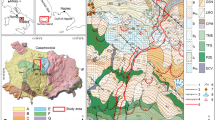Abstract
Especially important for landslide prevention activities is to recognize the potential path of the debris flows from the triggering point to the stop. The huge number of debris flow (over 2000), occurred after 2007 in the Messina Municipality area, has allowed to evaluate the runout of these phenomena in the geographical area of the Peloritani Mountains. A preliminary runout analysis was carried out plotting the mobilized volume by phenomena multiplied the altitude difference (∆ha) between the trigger point (Piff) and the stop point (Pip), in abscissa, and the distance travelled by the phenomena from the Piff to Pip, in the ordinate. Subsequently, these approach has been revised to make the applicability to potential phenomena more effective and easier to use. With this aim, was chosen to use the altitude difference (∆hb) between the trigger point (Piff) and the foot of the slope where the movement occurred. Starting from the location and size of the potential triggering areas and from the knowledge of the volume of the potentially mobilized material and basing on these curves, the runout of potential trigger areas has been estimated.
Research funded by the Messina Municipality
Access this chapter
Tax calculation will be finalised at checkout
Purchases are for personal use only
Similar content being viewed by others
References
Crosta GB, Dal Negro P, Frattini P (2003) Soil slips and debris flows on terraced slopes. Nat Hazards Earth Syst Sci 3:31–42
Dikau R, Brunsden D, Schrott L, Ibsen ML (eds) (1996) Landslide recognition: identification, movement, and causes. Wiley, New York, 1996, p 210
García-Ruiz JM, Beguería S, Lorente A, Martí C (2002) Comparing debris flow relationships in the alps and in the pyrenees. Instituto Pirenaico de Ecología, Zaragoza, Spain
Hungr O, Leroueil S, Picarelli L (2013) The varnes classification of landslide types, an update. Landslides, 1–28, November 30, 2013
Puglisi C, Falconi L, Grauso S, Screpanti A, Verrubbi V, Zini A, Crovato C, Campolo D, Leoni G, Lumaca S, Malerba S, Brustia E, Comerci V, Lucarini M, Napoli R, Torre A, Pino P (2013) Valutazione della pericolosità da frana nel territorio del Comune di Messina. ENEA RT-2013-18, Roma, p 161. http://hdl.handle.net/10840/4771
Rickenmann D (1999) Empirical Relationships for debris flows. Nat Hazards 19:47–77
Author information
Authors and Affiliations
Corresponding author
Editor information
Editors and Affiliations
Rights and permissions
Copyright information
© 2015 Springer International Publishing Switzerland
About this paper
Cite this paper
Puglisi, C., Falconi, L., Gioè, C., Leoni, G. (2015). Contribution to the Runout Evaluation of Potential Debris Flows in Peloritani Mountains (Messina, Italy). In: Lollino, G., et al. Engineering Geology for Society and Territory - Volume 2. Springer, Cham. https://doi.org/10.1007/978-3-319-09057-3_84
Download citation
DOI: https://doi.org/10.1007/978-3-319-09057-3_84
Published:
Publisher Name: Springer, Cham
Print ISBN: 978-3-319-09056-6
Online ISBN: 978-3-319-09057-3
eBook Packages: Earth and Environmental ScienceEarth and Environmental Science (R0)




